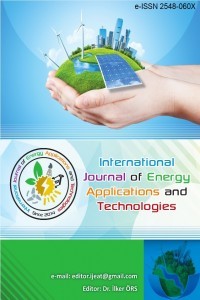Policy intervention and its consequences on the environment to combat climate change– A case from Bhutan
Policy intervention and its consequences on the environment to combat climate change– A case from Bhutan
Bhutan, Greenhouse Gas (GHG), Gross National Happiness (GNH), Holistic socioeconomic development Sustainable Development Goals (SDGs),
___
- Pawelzik, P., Carus, M., Hotchkiss, J. et.al. 2013. Critical aspects in the life cycle assessment (LCA) of bio-based materials – Reviewing methodologies and deriving recommendations. Resources, Conservation and Recycling, 73, 211-228.
- GHGP. Product life accounting and reporting standard. The Greenhouse Gas Protocol World Resources Institute & World Business Council for Sustainable Development; 2011. http://www.ghgprotocol.org/ standards/product-standard
- Stavins, R. N., and Stowe, R. C. 2018. International cooperation in East Asia to address climate change. Harvard Project on Climate Agreements With the support of The Harvard Global Institute. https://www.belfercenter.org/sites/default/files/files/publication/harvard-project-east-asia.pdf. (February 2018.)
- Althor, G., Watson, J. E., and Fuller, R. A. 2016. Global mismatch between greenhouse gas emissions and the burden of climate change. Scientific Reports, 6(1). 1-6.
- Zhang, X., and Xu, J. 2018. Optimal policies for climate change: A joint consideration of CO2 and methane. Applied Energy, 211, 1021-1029.
- Ekwurzel, B., Boneham, J., Dalton, M. W. et.al. 2017. The rise in global atmospheric CO2, surface temperature, and sea level from emissions traced to major carbon producers. Climatic Change, 144(4), 579-590.
- Adzawla, W., Sawaneh, M., and Yusuf, A. M. 2019. Greenhouse gasses emission and economic growth nexus of sub-Saharan Africa. Scientific African, 3, e00065.
- Climate Analytics, Decarbonising South and South East Asia: Shifting energy supply in South Asia and South East Asia to non-fossil fuel-based energy systems in line with the Paris Agreement long-term temperature goal and achievement of Sustainable Development Goals. 1-80. (May 2019.)
- NEC, RGoB, 2020. Third National Communication to the UNFCCC, National Environment Commission of Bhutan, https://unfccc.int/sites/default/files/resource/TNC%20of%20Bhutan%202020.pdf. 1-182. (November 2020.)
- MacLeod, M., Moran, D. et.al. 2010. Developing greenhouse gas marginal abatement cost curves for agricultural emissions from crops and soils in the UK. Agricultural Systems, 103(4), 198-209.
- Rehan, R. and Nehdi, M. 2005. Carbon dioxide emissions and climate change: Policy implications for the cement industry. Environmental Science & Policy, 8(2), 105-114.
- NSB, RGoB. Population and Housing Census of Bhutan. National Statistics Bureau, Bhutan, 2017.
- NSB, RGoB. Statistical Year Book. National Statistics Bureau, Bhutan, 2019.
- GNH Centre, Bhutan, What is GNH. http://www.gnhcentrebhutan.org/what-is-gnh/the-4-pillars-of-gnh/ (20th April 2021.)
- Montes, J., and Bhattarai, S. R. 2018. Buddhist biopower? – Variegated governmentality in Bhutan’s gross national happiness agenda. Geoforum, 96, 207-216.
- RGoB, The Constitution of the Kingdom of Bhutan, Royal Government of Bhutan, Bhutan, 2008.
- Wester, P. Mishra, A. Mukherji, A. and Shrestha, A. B. The Hindu Kush Himalaya assessment: Mountains, climate change, sustainability and people. Springer, 2019.
- Tobias, M. C. and Morrison, J. G. Why life matters: Fifty ecosystems of the heart and mind, Springer, 2014.
- Stefan, P. Gross National Happiness-Bhutan’s Vision of Development and its challenges.
- Tho, H. V. Gross National Happiness as an alternative development paradigm and its relevance for community living, Euroasia learning Institute for happiness and wellbeing, 2018, https://elihw.org/wp-content/uploads/2018/11/ELI_Camphill_and_TTG_V2_WEB-ilovepdf-compressed.pdf
- GHNC, RGoB. 13th Round Table Meeting, Gross National Happiness for the global goals, Gross National Happiness Commission, 2017, https://www.gnhc.gov.bt/13rtm/
- NEC, RGoB, Second National Communication to UNFCCC, National Environment Commission of Bhutan, 2011, https://unfccc.int/resource/docs/natc/snc_bhutan.pdf.
- Crippa, M. Oreggioni, G. Guizzardi, D. et.al. Fossil CO2 and GHG emissions of all world countries, EUR 29849 EN, Publications Office of the European Union, Luxembourg, 2019, ISBN 978-92-76-11100-9.
- NEC, RGoB, Third National Communication to UNFCCC, National Environment Commission of Bhutan, 2020, http://www.nec.gov.bt/wp-content/uploads/2020/10/TNC_2020_Oct_Final.pdf.
- Worldometers, Bhutan Co2 emission, 2021, https://www.worldometers.info/co2-emissions/bhutan-co2-emissions/. (20 April 2021.)
- Jamyag D. Dorji, S. et al. 2013. Public Awareness of Environmental Policies in Bhutan, BJRD, 1-14.
- MoEA, RGoB, Economic Development Policy, Ministry of Economic Affairs, 2016.
- RGoB, Sustainable Development and Happiness, 2018, https://sustainabledevelopment.un.org/content/documents/19369Bhutan_NSDGR_Bhutan_2018.pdf.
- Bale, C. S. Varga, L. and Foxon, T. J. 2015. Energy and complexity: New ways forward, Applied Energy, 138, 150-159.
- DRE, RGoB, National Energy Efficiency Roadmap, Department of Renewable Energy, 2019.
- Bhattarai. H. 2021. Policy Driven Initiative for Promoting Electric Vehicles to Combat Climate Change in the Developing Countries: A case from Bhutan, IOER-IMRJ, Vol. 3, No. 1, pp. 11-20.
- Druk Green Power Corporation Ltd., 2021, https://www.drukgreen.bt/
- Månberger, A. 2018. Deep Decarbonization and Energy Security for Low-Carbon Societies, Green Growth and Decarbonization of Energy Systems in a Changing World. Rocamora, A. R. & Ishikawa, T. (eds.). Hayama: Institute for Global Environmental Strategies (IGES), p. 14-16.
- National Newspaper, Bhutan Green House Gas Emission to Rise if nothing changes, Kuensel Coorporation, Bhutan, https://kuenselonline.com/bhutans-greenhouse-gas-emissions-to-rise-if-nothing-changes/, 2021.
- Yangka, D. and Newman, P. 2018. Bhutan: Can the 1.5 °C agenda be integrated with growth in wealth and happiness? Urban Planning, 3(2), 94-112.
- ADB, Bhutan Transport 2040 Integrated Strategic Vision, Asian Development Bank, 2013.
- Yayın Aralığı: Yılda 2 Sayı
- Başlangıç: 2014
- Yayıncı: İlker ÖRS
Overview a nearly zero energy building
Yousif Mustafa Sadeq AL-KHDHAİRİ, Ahmet Mete VURAL
Solar power plant generation forecasting using NARX neural network model: A case study
Obed NKURIYINGOMA, Saltuk Buğra SELÇUKLU
The influences of gasoline and diesel fuel additive types
Investigation of the improvement of Sivas-Kangal lignites liquefaction product yields
